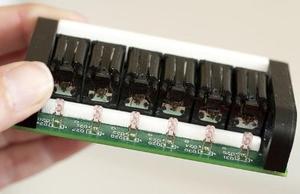DetectionNew device uses sniffer bees to detect explosives
The unassuming honeybees have a hidden talent — an even keener sense of smell than anyone first expected — which could make them one of the U.K.’s most ruthless and worst-feared weapons against terrorism; researchers developed a portable handheld sensor that holds thirty-six trained bees gently restrained in six cassettes inside the device; each is taught to recognize a particular odor and associate that smell with a food reward; the researchers have already trained their honeybees to detect a wide variety of explosive compounds and mixtures, including Semtex, C4, PE4, TNT, DMNB, gunpowder, and hydrogen peroxide

Cassette containing six trained sniffer bees // Source: wordpress.com
Honeybees appear to be simple creatures, buzzing from flower to flower and occasionally startling an innocent passerby. These unassuming insects also have a hidden talent that could make them one of the U.K.’s most ruthless and worst-feared weapons against terrorism.
Two years ago, the government funded a project to harness the olfactory ability of bees in detecting trace vapor to catch terrorists and drug smugglers. The Engineer reports that a group of researchers in Hertfordshire quietly went to work on a sensor that could do just that. In the course of their research, they discovered that honeybees have an even keener sense of smell than anyone first expected. The device they finally came up with astonished security experts, both for its radical approach and for its levels of accuracy.
“Our sensor integrated live honeybees as the main component,” said lead researcher Mathilde Briens. “For a long time people really wouldn’t believe that this was serious work and, even now, many people are amazed by what we’re doing - we usually get a few smiles and often some raised eyebrows.”
Under the government contract, Inscentinel, a spin-out of Rothamsted Research, developed a portable handheld sensor known as the VASOR136 (volatile analysis by specific olfactory recognition). The system can hold thirty-six trained bees gently restrained in six cassettes inside the device. Each is taught to recognize a particular odor and associate that smell with a food reward.
“We see the bee more like a tool in the machine rather than an insect,” said Briens. “Combining biology and engineering together like this makes the system far more reliable. For instance, we know there are a lot of issues with sniffer dogs because of their relationship with the dog handler. If you use some engineering instead, it makes the human factor disappear.”
The Engineer quotes the researchers to say that honeybees are ideal detectors because they are inexpensive, widely available, and can be trained within minutes. They also have extremely low limits of detection, with trace vapors being picked up in parts per trillion levels, comparable to the accuracy of a sniffer dog.
The researchers have already trained their honeybees to detect a wide variety of explosive compounds and mixtures, including Semtex, C4, PE4, TNT, DMNB, and gunpowder.
They have also been successful in training their bees to detect hydrogen peroxide, which is one of the compounds known to be used in home-made explosives.
In a test for the U.K. Office for Security and Counter Terrorism, the VASOR136 compared favorably with existing detection technology. The design of the trial was adapted from an aviation check-point protocol used in tests for trace detection equipment. Control measurements were conducted using gas chromatography-mass spectrometry (GC-MS) analysis of the explosive samples to establish the concentration detected.
